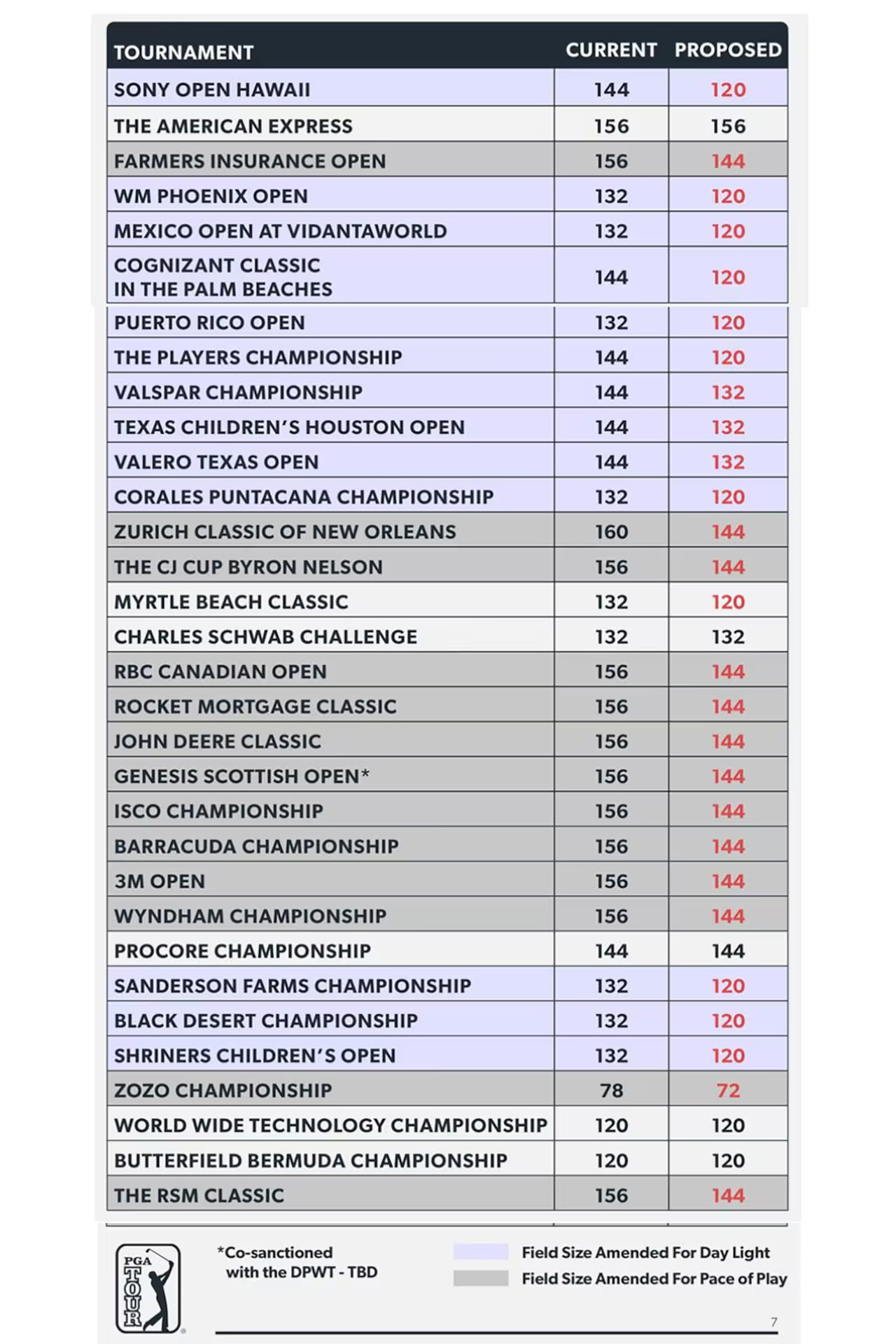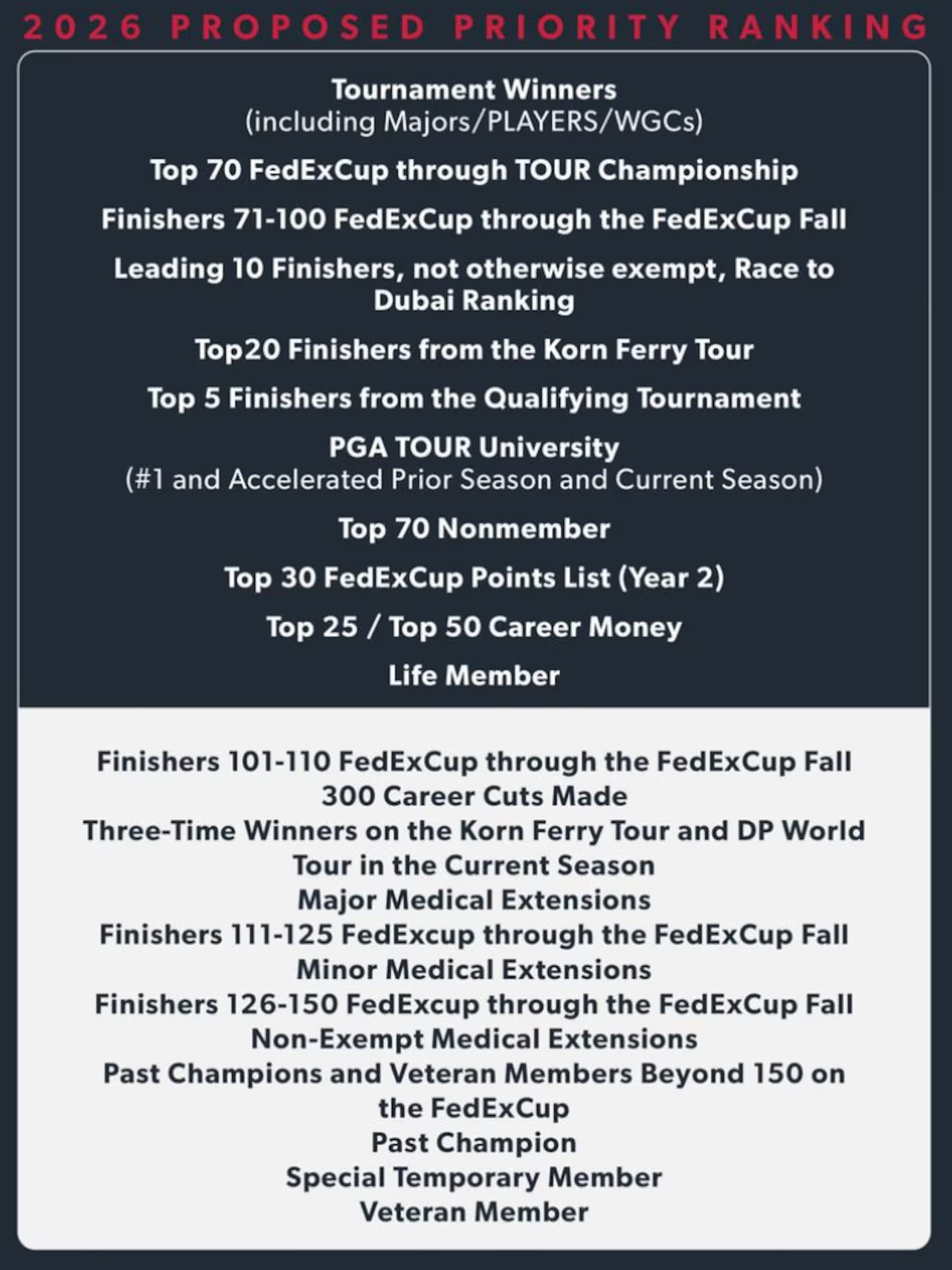The six-player directors on the PGA Tour Policy Board, in conjunction with the 16 players making up the Player Advisory Council (PAC) have proposed sweeping changes to the tour that affect everything from field size to membership status to sponsor exemptions and Monday qualifying.
“Over the course of 2024, field sizes and pace of play, along with playing privileges and the FedEx Cup points system, have been the areas in which the tour has received the most feedback from the membership,” the PAC wrote in an executive summary memo released to the entire PGA Tour membership on Tuesday, a copy of which was obtained by Golf Digest.
“Throughout this project, which began at the PAC meeting at the Charles Schwab Challenge and was approved at the Policy Board meeting in June, the PAC conducted a comprehensive review of ideal field sizes and, in turn, the overall eligibility system, to ensure the PGA Tour delivers the optimal experience to the membership and a more competitive and entertaining PGA Tour to our fans, sponsors, tournaments and other stakeholders.”
The proposed changes, outlined below, are subject to approval by the tour’s Policy Board at its next meeting Nov. 18 (the Tuesday of the RSM Classic). That approval, however, is essentially believed to be a foregone conclusion—the Policy Board includes the six player directors who helped draft the amendments, and the process is unlikely to have progressed this far without the approval of tour higher-ups.
The starting point for the proposed changes stemmed from a desire to reduce the field size of tournaments throughout the calendar year. The proposal creates a new maximum field size for a one-course full-field event at 144 players (down from the current 156), but that number can be reduced to 132 or even 120 depending on considerations like daylight. The Players Championship, for instance, would see its field reduced from 144 players to 120, a decrease of almost 17 percent. There was discussion about increasing the field sizes in signature events to offset these reductions, but ultimately no change was made, with a minimum field size already in place of 72.
“Field sizes that are too large make it difficult to finish the competition on schedule each day and cause delays in the overall pace of play, increasing the average round times,” the PAC wrote to explain the thought process in reducing fields. In a series of charts, the memo demonstrated that a high percentage of tournaments over the past two years had suffered delays even without a weather stoppage, and that a major cause of slow play on Thursdays and Fridays, when groups start on each nine, was the delay incurred at the turn while waiting for other groups to start their rounds.
The chart below, from the tour’s memo, shows the proposed new field sizes of each event on the calendar:

The reduction in field size necessitates an even more fundamental change for the tour regarding eligibility, with the PAC outlining a reduction in the number of PGA Tour cards that will be available as well as changes in exemptions that help fill out weekly fields.
“Based on the proposed field sizes and to ensure adequate participation in open, full-field events,” the memo reads, “the number of exempt members should be reduced by approximately 20-25 percent.”
The cut to tour membership will be accomplished by a few different methods, including:
—An amendment changing the top 125 membership category to the top 100, a 20-percent reduction and the first since the PGA Tour went to its “all-exempt” structure in 1983.
—A reduction in cards available from the Korn Ferry Tour from 30 to 20.
—An adjustment for PGA Tour Q-School graduates from “top five and ties” to simply “top five.”
The DP World Tour will maintain its current total of 10 available cards from the Race to Dubai rankings.
In an effort to “minimize the impact of field size on changes on the current membership,” the tour proposes two additional changes within tournaments. Most notably, “Open Qualifying,” commonly known as Monday qualifying, would be eliminated entirely for tournaments with fields of 120 players or fewer, and reduced from four spots to two in 132-player events. This change, the memo says, stems from metrics that show that 65 to 70 percent of Monday qualifiers miss the cut, and a desire to reward members on the priority ranking list in their stead.
Additionally, “restricted sponsor’s exemptions”—two for tour members and two for DP World Tour/KFT/Q-School members—will be reallocated to the priority ranking of tour members. Tournaments would keep their four unrestricted exemptions.
In all, the new system proposes an entirely new priority ranking system:

The memo went on to outline other proposed changes to the tour structure, including tweaks to the allocation of FedEx Cup points. Second-place points at the Players and majors will increase, while positions 11 and lower in those events will decrease. A corresponding decrease in points to positions lower than sixth in signature events is also included in the proposal.
The rules committee also proposed specific changes to the tour’s pace-of-play policy beyond the field reductions. Interestingly, most of these proposals involve giving players more time to hit and reducing or eliminating fines based on bad times. The two exceptions are an increase in fines for the slowest players as identified by the Average Stroke Time policy.
In working to prepare the proposal, the six player directors and the 16 members of the PAC split into four subcommittees. The Competitions & Regulations subcommittee, which worked on the proposal for field size changes, consisted of player director Adam Scott and PAC members Brian Harman, Seamus Power, Lanto Griffin, and Sam Burns. The Pathways subcommittee, which proposed the changes to gain access to tour membership and tour events, was led by player directors Peter Malnati and Webb Simpson, and included PAC members Camilo Villegas (chairman of the PAC), Nick Taylor, Maverick McNealy and Josh Teater.
Main Image: Christian Petersen









